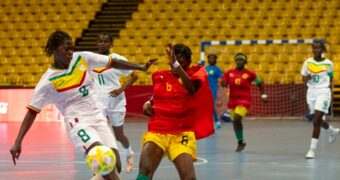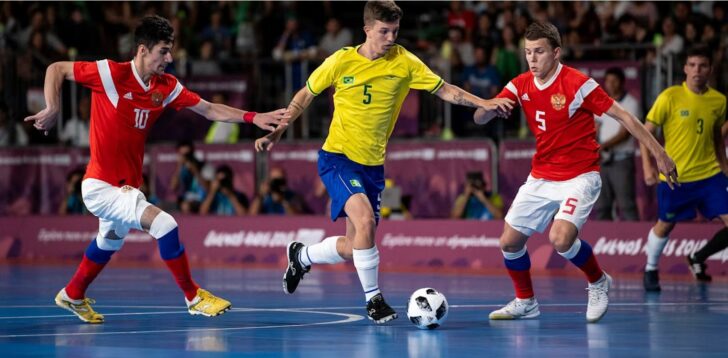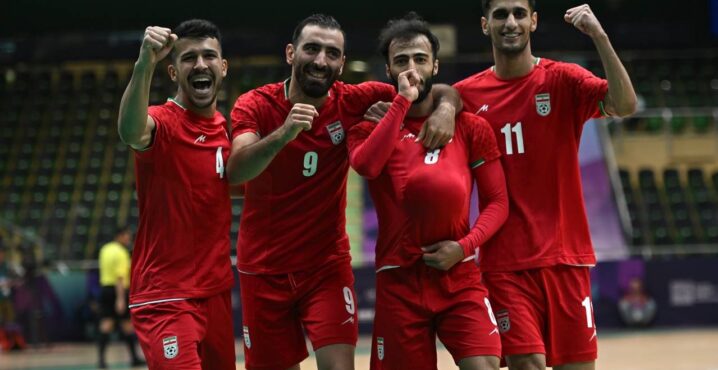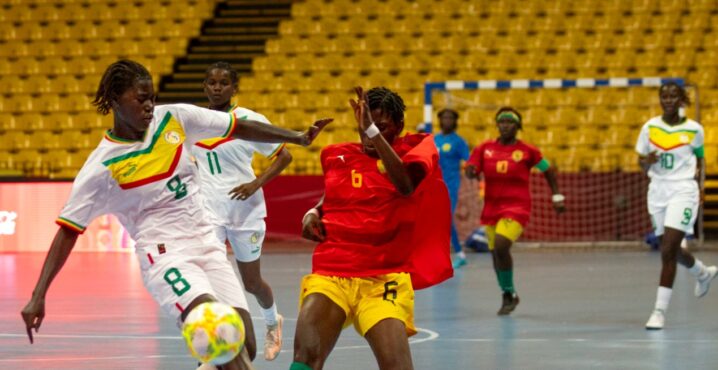Estimated reading time:8 minutes, 2 seconds
Despite aligning with Olympic values and growing in popularity, futsal faces significant hurdles for inclusion in the Games. With U.S. Soccer’s lack of support and a crowded field of new sports, advocates must explore alternative pathways for futsal’s Olympic debut.
We had already addressed this subject in our article: Futsal and the Olympics: Exploring Current Exclusions and Future Opportunities however, a few days ago, Eurosport published an article titled “2024 Olympics – Football – The Case for Futsal: ‘We Should Be in the Olympics’” that has garnered much attention within the Futsal community. In this piece, journalist Matéo Bastian explores how futsal, aligns closely with the values upheld by the International Olympic Committee (IOC). Despite this, futsal remains absent from the Olympic Games. In contrast, traditional eleven-a-side football’s place in the Olympics is increasingly questioned, as it seems to diverge from the Olympic spirit. He claims there are growing indications that futsal might be poised to represent football within the Olympic movement. Below is his article and we follow it with our own thoughts:
“Football is not an Olympic sport.” This statement was made by Michel Platini in an interview with Midi Libre on July 22, just days before the Olympic tournament. When a legend of French football speaks like this, it’s worth listening.
To be fair, the 2024 tournament hasn’t been particularly exceptional, apart from the remarkable yet expected progress of Thierry Henry’s team, who progressed to the final for the first time since 1984. Yes, France has already been an Olympic football champion in Los Angeles. Still, that victory went relatively unnoticed, especially in the summer of the national team’s first major title at the European Championship. Twenty years later, in Paris, what stands out are the extended matches, incidents, and the overall poor quality of play, rather than the Olympic spirit.
This is no surprise, as the two entities have grown apart over time. The creation of the World Cup in 1930, a global event that competed with the Olympics, has gradually distanced football from the Olympic sphere. Thierry Henry’s struggles to assemble a squad for a competition outside the FIFA calendar highlight the gap between the two institutions.
Futsal is far removed from these considerations but still ticks many of the right boxes. Firstly, it aligns perfectly with the values promoted by the IOC, which seeks to highlight youthful and dynamic sports, like 3×3 basketball or rugby sevens. Five-a-side football, played on a smaller pitch, with two 20-minute halves and 4 seconds to take throw-ins or free kicks, offers a spectacular game with short, intense sequences that spectators love.
It’s a sport growing increasingly popular with the general public: “Futsal is the number one activity in schools for both boys and girls. Today, we have over 250,000 participants in France,” says Philippe Lafrique, a member of the FFF’s Executive Committee and responsible for futsal development. The numbers are telling in France, with 50,000 registered players today compared to 30,000 five years ago.
Globally, FIFA estimates that around 30 million people play futsal: “It’s a universal sport present on all five continents, with different dominant nations like Iran, Brazil, Morocco, and Spain. For the past three years, the French team has been playing to sold-out crowds, and we have an incredible popular momentum,” says Raphaël Reynaud, the current coach of the French team, who are preparing at Clairefontaine for the World Cup in Uzbekistan this September.
From an organizational standpoint, futsal has advantages over eleven-a-side football: “It’s much easier to manage, with shorter matches, less need for recovery time between games, and the ability to use handball courts. The arenas are more easily filled… futsal fits the Olympic schedule perfectly.” Organizing a five-a-side football tournament could generate real Olympic excitement, as it could be held in the same venues as other sports like handball or basketball. This enthusiasm would be a welcome change, given the challenges eleven-a-side football faces in fully integrating into the Olympic spirit.
However, the idea is not to replace traditional football with futsal: “The two disciplines are complementary, like basketball and 3×3. The FFF is pushing for futsal to be included in the Olympics alongside eleven-a-side football. The latter is still very important for many nations, especially in women’s football,” adds Philippe Lafrique. So, there’s no confrontation between the two but rather complementarity, with each needing the other.
Already present at the 2018 Youth Olympic Games in Buenos Aires, the journalists claims that futsal has a strong chance of being a demonstration sport in 2028. This prospect excites Pierre Jacky, former coach of the French team from 2004 to 2021: “Futsal must be in the Olympics; it fits the times: fast, dynamic, and spectacular.” There’s no better place than Los Angeles, a trendy and ever-relevant city, to test it out.
Respectfully disagree
I must respectfully disagree with Matéo Bastian’s analysis, although I appreciate his enthusiasm and the French Football Federation’s aspirations for futsal’s inclusion in the Olympics. At the same time, we would love it if futsal was included but let’s consider the sports that have been confirmed for the 2028 Olympics: flag football, lacrosse, baseball and softball, squash, and cricket.
Flag Football
Various organizations and leagues, including the NFL and USA Football, have been actively promoting flag football. Programmes like the “NFL Flag” initiative in the 1990s that encouraged youth participation, and helped fuel the sport’s growth and today 700,000 participants take part.
Lacrosse Sixes
Lacrosse, originally known as ‘stickball,’ has deep cultural roots among Indigenous North American communities. Traditionally dominated by the United States and Canada, the sport features a storied rivalry, with the U.S. leading with 11 men’s field lacrosse World Championships compared to Canada’s three. The 2028 Olympics will feature the World Lacrosse Sixes format—a faster, high-tempo version of the traditional game. Played on a 70m x 36m pitch with six players per team and a 30-second shot clock, Sixes aims to offer an engaging, accessible spectacle, much like rugby sevens.
Baseball and Softball
Baseball, which originated in England in the 1700s, gained immense popularity in the U.S. during the 19th century, leading to the establishment of professional leagues by 1875. Softball, developed in Chicago in the late 1880s, was formalized as a distinct sport by 1926. Baseball and softball will return to the Olympics in 2028, with baseball appearing for the seventh time and softball for the sixth.
Squash
The World Squash Federation (WSF), US Squash, and the Professional Squash Association (PSA) have all supported squash’s inclusion in the Olympics. In the U.S., approximately 1.49 million people aged six and older play squash, highlighting its broad appeal.
Cricket
Cricket is surging in popularity in the United States, marked by Team USA’s notable victory over Pakistan in the Men’s T20 World Cup, which was considered a historic upset. The sport, with strong roots in South Asia and Australasia, is gaining traction in the U.S. due to demographic shifts and increased immigration. The sport’s growth is bolstered by significant investments and its inclusion in the 2028 Olympics.
The common thread among these sports is their strong establishment in the U.S. or robust support from their governing bodies and business stakeholders. This backing is crucial for Olympic inclusion, which may explain why sports like futsal, despite their merits, are still striving for a spot in the Games.
In the U.S., the development of futsal on a national scale has unfortunately not been a priority for U.S. Soccer. Instead, this responsibility has been largely taken on by the U.S. Futsal Federation, which was founded in 1981 by Alex Para. The U.S. Futsal Federation focuses on grassroots growth, while U.S. Soccer remains responsible for the men’s and women’s national futsal teams, incorporating futsal into their extended national team programme without developing youth teams below this level. This arrangement may be a result of an agreement with the U.S. Futsal Federation.
For futsal to be included in the Olympic program, the sport needs the backing of its national governing body. However, the U.S. Futsal Federation’s influence is limited, as FIFA and the American Olympic Committee will primarily recognize U.S. Soccer as the governing body for both football and futsal in the U.S., despite their arrangement with the U.S. Futsal Federation. Unfortunately, U.S. Soccer has shown little interest in promoting futsal at the national level, significantly reducing the chances that FIFA or the American Olympic Committee will push for its inclusion in the Olympics.
If France truly wants futsal to be part of the Olympics, it might be more strategic to push for its inclusion in the Winter Olympics, especially if they host the next competition. France has provisionally been chosen to host the 2030 Winter Olympics and Paralympics.
Organ Donation
Futsal Focus is a supporter of Dáithí Mac Gabhann and his family’s campaign to raise awareness of Organ Donation. We encourage our readers to learn more about Organ Donation: https://www.organdonation.nhs.uk/
Futsal Focus
You can read more articles about International Futsal by going to the top navigation bar or by clicking here
If you like this article and would like to keep updated on Futsal news, developments, etc. You can now follow Futsal Focus via Google News. By following our page which will send you an alert as soon as we publish an article. Please click here and follow us on Google.
You can also keep updated on Futsal news, developments by submitting your email below in the Subscribe to Futsal Focus option.
Follow Futsal Focus by clicking on Facebook, Twitter, or Instagram or on the social media buttons on the website.
















![Validate my RSS feed [Valid RSS]](https://www.futsalfocus.net/wp-content/uploads/2020/01/valid-rss-rogers.png)




